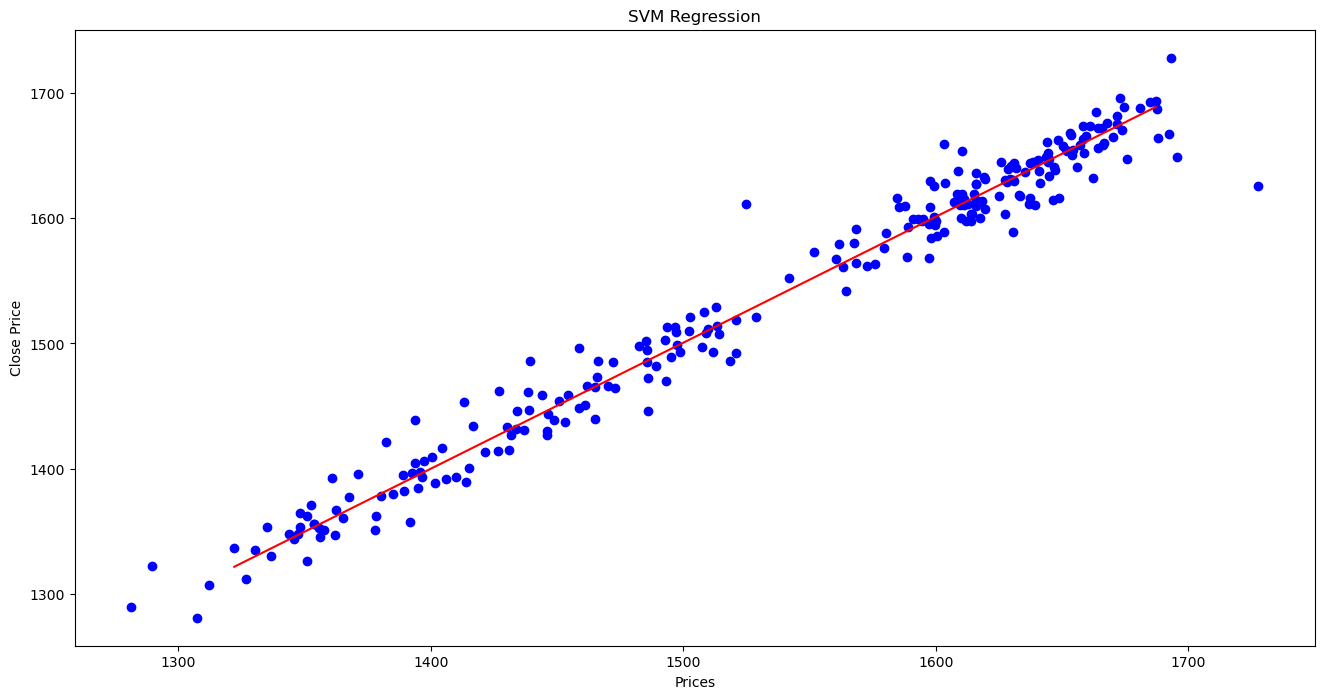Support Vector Regression (SVR)
Support Vector Regression (SVR) is a type of support vector machine (SVM) that's used for regression tasks—predicting a continuous target variable. Unlike SVM classification, which aims to find the optimal hyperplane to separate data points into different classes, SVR aims to find the best-fitting hyperplane that minimizes the error between predicted and actual values while maximizing the margin.
⚠ HOTS
Hyperplane in Different Dimensions:
1 Dimension: A single point.
2 Dimensions: A line.
3 Dimensions: A plane.
Higher Dimensions: A hyperplane is a generalization of these concepts to higher
dimensions that we can't easily visualize.
The primary objective of an SVM is to find the best hyperplane.
This module outlines the following steps:
➤ 1. Import data
➤ 2. Import libraries and Split data
➤ 3. Model training
➤ 4. Prediction
➤ 5. Compare the actual and predicted values
➤ 6. Evaluate the model
➤ 7. Predicting Close Price with generated input data
➤ 8. Strengths and Weaknesses
Support Vector Regression (SVR)
↪ 1. Import data
Import data using read_csv() function.
import pandas as pd
data = pd.read_csv('https://raw.githubusercontent.com/csxplore/data/main/andromeda-technical.csv',
header=0)
print(data.columns)
---Output---
# Index(['Symbol', 'Series', 'Date', 'Prev Close', 'Open Price', 'High Price',
# 'Low Price', 'Last Price', 'Close Price', 'Average Price',
# 'Total Traded Quantity', 'Turnover', 'No. of Trades', 'Deliverable Qty',
# '% Dly Qt to Traded Qty', 'SMA20', 'SMA50', 'diff', 'UP'],
# dtype='object')
Support Vector Regression (SVR)
↪ 2. Import libraries and Split data
The code below trains a Support Vector Regression (SVR) model using scikit-learn to predict a “Close Price” based on the “Prev Close” price from the dataset. The code preprocesses the data by selecting relevant columns, splitting them into training and testing sets, and then training an SVR model with a linear kernel.
The trained model can then be used to make predictions on new data, and its performance can be evaluated.
# Import necessary libraries
import numpy as np
import matplotlib.pyplot as plt
from sklearn.svm import SVR
from sklearn.model_selection import train_test_split
from sklearn.metrics import mean_squared_error, r2_score
from sklearn.preprocessing import StandardScaler
import warnings
warnings.filterwarnings('ignore')
#
# Choose the required columns for analysis. This exercise predicts the Close Price using the
# Previous Close Price.
columnname = ['Prev Close']
x = data[columnname]
y = data['Close Price']
#
# Split the data into training and testing sets
x_train, x_test, y_train, y_test = train_test_split(x, y, test_size=0.2, random_state=42)
print("x_train.shape: ", x_train.shape )
print("x_test.shape: ", x_test.shape )
print("y_train.shape: ", y_train.shape )
print("y_test.shape", y_test.shape )
---Output---
# x_train.shape: (200, 1)
# x_test.shape: (50, 1)
# y_train.shape: (200,)
# y_test.shape (50,)
Support Vector Regression (SVR)
↪ 3. Model training
The SVR() function instantiates a Support Vector Regression (SVR) object.
# Create an SVM regression model svr = SVR(kernel='linear', C=1.0, epsilon=0.2)kernel='linear': This specifies the kernel function to use. The kernel is a function that maps the data to a higher-dimensional space where it might be linearly separable. 'linear' indicates a linear kernel, meaning the model will search for a linear relationship between the independent and the dependent variable. Other options include 'rbf' (radial basis function), 'poly' (polynomial), and 'sigmoid'.
C=1.0: This is the regularization parameter. It controls the trade-off between maximizing the margin and minimizing the training error. A larger C value means the model will try to fit the training data more closely, whereas a smaller C value prioritizes a larger margin. The value 1.0 represents a balance, but the optimal C often needs tuning based on the specific dataset.
epsilon=0.2: This is the epsilon parameter of the epsilon-SVR (epsilon-insensitive support vector regression). It defines the size of the margin of tolerance around the regression hyperplane. Data points within this margin are not penalized in the model training. An epsilon of 0.2 means the model will tolerate errors up to a magnitude of 0.2 without penalty. The choice of epsilon affects how tightly the model fits the data.
Train the model
svr.fit(x_train, y_train)
Support Vector Regression (SVR)
↪ 4. Prediction
The code below uses the trained SVM regression model to make predictions on new, unseen data.
prediction = svr.predict(x_test)
The code compares the model's predictions to the actual values from the test dataset (y_test). It creates a Pandas DataFrame to display the first 10 'Actual' versus 'Predicted' values, providing a quick visual check of the model's performance on unseen data. Compare the actual and predicted values
y_pred = pd.DataFrame(prediction, columns=['Pred']) dframe = pd.concat([y_test.reset_index(drop=True).astype(float),y_pred], axis=1) dframe.columns = ['Actual','Predicted'] graph = dframe.head(10) print(graph)
---Output--- # Actual Predicted # 0 1597.65 1613.100311 # 1 1367.40 1362.553830 # 2 1458.65 1444.160972 # 3 1464.85 1473.288444 # 4 1611.15 1525.416576 # 5 1655.90 1665.529761 # 6 1568.55 1589.597454 # 7 1614.20 1647.701739 # 8 1326.60 1351.003281 # 9 1496.70 1459.076247
The code below uses SVR model to predict a “Close Price” based on a single input value. The svr.predict([[1508.80]]) line feeds the value 1508.80 to the model, which then generates a prediction.
Predict_Close_Price= svr.predict([[1508.80]])
print("Predicted Value: ", Predict_Close_Price)
---Output---
# Predicted Value: [1509.39646603]
Support Vector Regression (SVR)
↪ 5. Compare the actual and predicted values
graph.plot(kind='bar')
plt.title('Actual vs Predicted')
plt.ylabel('Closing price')
plt.show()

Support Vector Regression (SVR)
↪ 6. Evaluate the model
This code evaluates the performance of a regression model by calculating and printing two common regression metrics: Mean Squared Error (MSE) and R-squared (R²).
mse = mean_squared_error(y_test, y_pred)
r2 = r2_score(y_test, y_pred)
print(f"Mean Squared Error: {mse}")
print(f"R-squared: {r2}")
---Output---
# Mean Squared Error: 399.1788532959891
# R-squared: 0.9716772691254852
MSE measures the average squared difference between the true values and the predicted values. A lower MSE indicates better model performance (smaller prediction errors). The average squared difference between the actual and predicted values is 399.18.
R² represents the proportion of the variance in the dependent variable that's predictable from the independent variables. It ranges from 0 to 1, with higher values indicating a better fit. An R² of 1 means the model perfectly explains the variance in the data, while an R² of 0 means the model doesn't explain any of the variance. R² = 0.97 suggests that the model explains about 97% of the variance in the target variable.
Support Vector Regression (SVR)
↪ 7. Predicting Close Price with generated input data
Create input data in the x_test range in the interval of 1, and predict the Close Price for each generated input data.
x_grid = np.arange(x_test.values.min(), x_test.values.max())
# Reshape the data into a len(x_grid)*1 array, i.e. to make a column out of the x_grid values
x_grid = x_grid.reshape((len(x_grid), 1))
#
plt.figure(figsize=(16,8))
plt.title('SVM Regression')
plt.xlabel('Prices')
plt.ylabel('Close Price')
print("x", x.size)
print("y", y.size)
plt.scatter(x, y, color = "blue")
plt.plot(x_grid, svr.predict(x_grid), color = 'red')
plt.show()

Support Vector Regression (SVR)
↪ 9. Strengths and Weaknesses
Support Vector Regression (SVR), a powerful technique for regression tasks, offers several advantages but also comes with certain limitations. Strengths
Weaknesses
